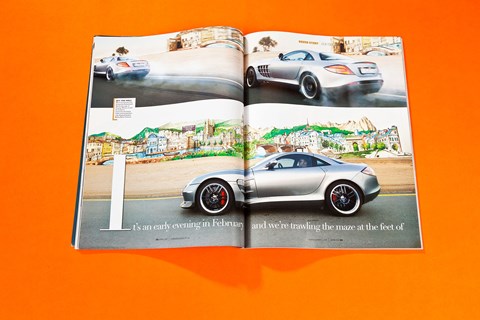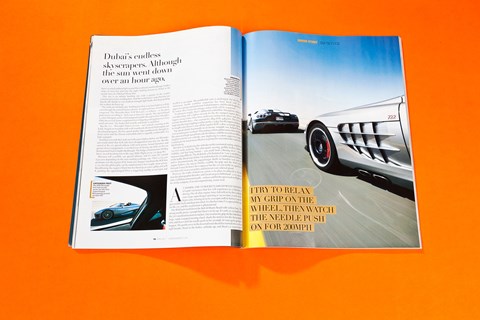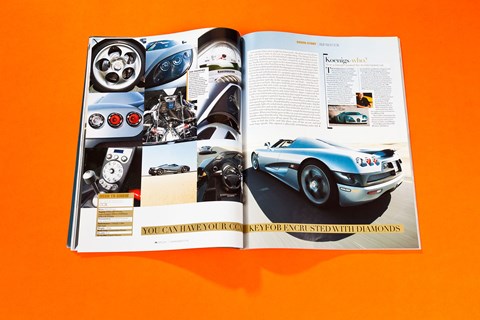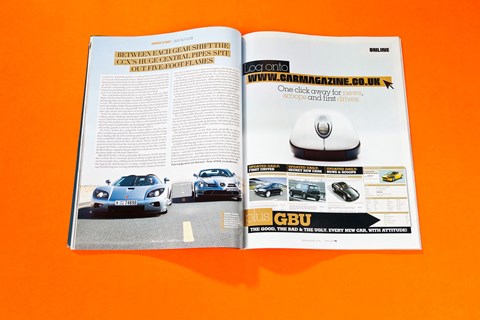► Topping 200mph in a McLaren and Koenigsegg
► Dubai desert is the epic backdrop
► One of our CAR+ archive adventures
How does it feel to top 200mph in the new McLaren SLR 722 and the outrageous Koenigsegg CCX? The best place to find out is in Dubai, on a particularly long stretch of trans-desert tarmac.
It’s an early evening in February and we’re trawling the maze at the feet of Dubai’s massed skyscrapers. Although the sun went down over an hour ago, there’s so much ambient light around that you barely need headlamps. Endless strips of neon tint and tone the night, bathing downtown Dubai in the moody hues of a Michael Mann film. This city is an infinite building site – a quarter of the world’s construction cranes reside here. And the work doesn’t stop when the sun knocks off, thanks to vast, stadium-strength light banks. Eighty floors up, the work just goes on and on, night and day.
The roads are similarly epic. Nothing less than a six-lane highway will do, even through the central business district. At night each lane remains heavily congested, and the Mercedes-Benz SLR McLaren 722 Edition (what a mouthful!) feels taut at these low speeds. The supercharged 5.5-litre V8 engine emits a bad-tempered rumble through its four side-pipes, while the revised, firmer suspension has it fidgeting and jiggling over every small intrusion. The brakes feel snatchy and tricky to modulate.
But the 722 – Mercedes’ fastest car ever – isn’t entirely straining at theleash. Despite its truculent wob-wob soundtrack, the hand-built engine can do relaxed progress, the five-speed slusher slips unobtrusively through its lower ratios and the climate-controlled cabin is superbly comfortable, if a little cramped.

You’d have to yank their nails out with a pair of pliers before anyone at Mercedes would admit that SLR sales have disappointed, but the arrival of the 722 special edition, with more power, honed dynamics and greater driver engagement, is an ideal way of closing any holes in the net that potential buyers might slip through. And why 722? The badge commemorates Stirling Moss’s record-breaking run in the 1955 Mille Miglia in a Mercedes 300 SLR, car number 722.
McLaren will assemble 150 special editions – yours for around £350,000 depending on the euro-sterling exchange rate. That’s a £32,500 premium over the regular SLR. Some 300 changes transform the SLR into a 722, but the philosophy can be summarised as less weight, more power. Recalibrating the engine’s black box has freed up an extra 24bhp and 30lb ft, pushing the supercharged V8 to a staggering 650bhp at 6500rpm and 605lb ft at 4000rpm. The paddleshift auto is unchanged, but the forged aluminium double wishbone suspension has been fitted with more aggressive springs and aluminium-bodied dampers, and the ride height drops by 10mm. The changes should reduce body roll by 20%.
To eliminate weight, there’s additional carbonfibre throughout, reduced soundproofing and a lighter oil tank for the dry-sumped engine. But the largest saving comes from those anthracite tuning-fork alloys and carbon ceramic Brembo discs – they account for 18kg of the 44kg lost. The 722 still steps into the ring weighing a portly 1724kg, but the improved power-to-weight ratio shaves 0.2sec off the regular SLR’s 3.8sec 0-62mph sprint.Top speed climbs fractionally to an insane 209mph, too, helped by the 722’s aerodynamic overhaul. That jutting carbon splitter more than doubles the amount of high-speed front-axle downforce, and the revised rear diffuser coupled with the more aggressively angled rear airbrake is more effective at gluing the rear end to the road under hard braking.
Not that we’re deploying the airbrake on this nocturnal outing, which the 722 isn’t really enjoying. The ultra-quick steering, grabby brakes, limited visibility and that long bonnet – you could land a Boeing on it – make manoeuvring difficult. The SLR feels hemmed in. I see a smallish gap in the traffic ahead and, before I’m undertaken by a Lamborghini Gallardo, nail it. Instantaneously, the supercharger shrills its banshee wail and the engine bellows, fat 295/30 Pirellis scrabble for grip and the SLR warps forward. It may be heavy for a supercar but the 722 can treble its speed at a rate that will sweat your palms.
However, the traffic-choked city centre is no place to unleash it. So the next day we head out past Dubailand – a 115 square mile, £10billion amusement park – at dawn and hit the open road on Highway 66. In the company of an uncompromising, exotic rival.
At 100mph the 722 rockets ahead with the kind of rapid viciousness that few will experience in a lifetime of driving. The all-alloy engine, force-fed cold air by the Lysholm screw-type supercharger spinning at 29,000rpm, is now in the hyper zone, homing in on its 7000rpm redline before I tap the gear paddle back and drop into third. It’s the first time I’ve opened the taps on the 722, and the acceleration is phenomenal.

The SLR hurls itself down the Bab Al Shams Road with violent fury. The arcing needle passes 150mph but there’s no let up. It’s only at 170mph that the 722’s acceleration starts to slacken. I try to relax my grip on the ridiculously large, suede-wrapped steering wheel, check the mirrors for the thousandth time and then watch the needle push on for 200mph. It’s not quite going to happen. The gentle curve in the deserted road ahead has turned into a sharp right-hander. Hard on the brakes, airbrake up, and there’s a surprising amount of movement at the back that calls for some quick steering tweaks to keep that long nose pointing straight.
The 722 may look outlandish with its Batman proportions, brash detailing and faux F1 nose, but it starts to look tame once the Koenigsegg CCX rocks up. Koenigsegg is an independent Swedish supercar maker giving the biggest names in exotics a run for their money. Like the SLR, the CCX runs a supercharged V8, but its ballistic output is 806bhp, sufficient for a claimed 245mph top speed.
We hook up with the Koenigsegg mid-morning, with the sun already burning down mercilessly. People stop, point and stare. The CCX looks just like a supercar should – wide, stubby, mid-engined, muscled and kerb-kissingly low. And those doors! Sure, the 722 has cool scissor doors but the Koenigsegg’s dihedral doors swing simultaneously up and out for the ultimate in gawp factor. There’s something very sharky about the CCX. It’s silvery grey, finned and staggeringly quick. Slightly bigger than its predecessor (the CCR), its airier cabin aims for a new sales target: Americans. The CCX also gets new headlamps, a revised front intake and splitter, a new rear diffuser, redesigned engine vents and a glass engine cover complete with flying ghost, symbol of the Swedish airforce. Ceramic brakes and carbon rims are optional extras.
To further boost the rigidity of the carbonfibre chassis, a vast new X-shaped cross member now spans the engine bay. And what an engine. Built in-house, the CCX’s 4.7-litre V8 is fitted with twin Rotrex centrifugal superchargers providing 1.2bar of boost, bumping up the engine’s outputs to a barely comprehensible 806bhp at 6900rpm and 678lb ft of torque at 5700rpm. The engine is fitted with a titanium exhaust system and carbonfibre cam covers, and sucks in air through reshaped side intakes. With both chassis and monocoque made from 21 layers of autoclave-baked epoxy-laminated carbonfibre, the car tips the scales at 1180kg. That’s 544kg – or the weight of a Caterham – less than the 722.

You can feel where that weight has been saved – the doors are Styrofoam light, and there’s little in the way of soundproofing. The fittings feel less robust too. Not that every SLR detail feels supercar special. The key is bog standard Mercedes, one that’s twisted by A-class drivers every day. You do, however, get a guns-to-live starter button, hidden in the shifter. The CCX has no key; just a solid silver shield-shaped immobiliser, also available in platinum with diamonds. Sheikhs will love it.
Press the small rubber button on the CCX’s fob and the windows fall two inches and the doors unlock. Drop down into the snug cabin, with its superb driving position and take in the sweeping view out front – and the non-existent view out back. Then press both the power and ignition buttons on that telephone dial-style centre console. There’s much fuel-pump whining and data-transfer humming as the Koenigsegg electronic synapses spark into life. Then push the power and starter buttons. Quite a rigmarole but worth every second when that engine hammers into life.
The 722’s engine is guttural, but the CCX’s apocalyptic soundtrack is on another level. It spits out a cacophony of valve-chain thrash, induction gasp and supercharger whine, all underlined by a menacing V8 thunder. Dip the surprisingly light clutch, grip that tall gearlever, push it an inch forward into first and on the smallest hint of throttle the CCX is spinning its rubber and snaking down the road. Below 50mph you need big inputs – gear changes start at the shoulder rather than the wrist. The steering is heavy, the brakes need a fierce kick.
Time to bolt the CCX’s roof into place, turn off the air-con and try for 200mph. It’s physically intimidating under full acceleration. Nailed through first, second and third, the car catapults forward. The digital speed readout jumps ahead in 25mph increments as it tries to catch up. It’s relentless. Faced with a shimmering, arrow-straight, deserted road I just keep going, punching the Cimatransaxle gearbox through its six precise gears every time the engine reaches its 6900rpm peak. We rush past 150mph, voraciously sucking the horizon towards us. The intense desert heat creates a haze which looks like molten lead in the smallest of dips. Between each gearshift, the CCX’s huge central exhaust pipes spit out bursts of orange and yellow flame.
Inside the cabin it’s a 3D wall of noise. Vibrations and tremors shake me and blur everything. Into sixth. The bend that pulled me short in the Merc is still nowhere to be seen when 200mph flashes up. Koenigsegg say there’s still another 45mph. I’ll take their word for it.
The CCX’s 362mm discs, gripped by six-pot calipers, have the same effect as a parachute, the car remaining flat and stable during heavy braking. But for all its terrifying speed, the CCX is also a car with some wonderfully subtle nuances. Above 60mph the steering frees up, creating a linear and tactile link to the wheels. The few bends on these roads reveal just how keen the steering is, pivoting the car into a corner. At speed, the brakes respond progressively to the smallest flex, and the double wishbone suspension keeps a tight rein on body movement, letting the chassis glide over the road. Impressive.
After the CCX, the 722 feels surprisingly dull and inert. It’s the steering that’s at fault. It’s nervously quick just off the straight ahead, but also frustratingly mute, robbing you of vital feedback from the tyres. And because it’s so sharp, at high speeds the smallest input has that long nose weaving and bobbing about. Despite its ferocious pace, the 722 doesn’t feel anywhere near as quick as the Swede, its lower output further hampered by additional weight and one less gear ratio. It takes time to coax 200mph from the 722, and given its instability under braking, I’m glad I didn’t push harder. The visceral sense of speed is also offset by the SLR’s refinement – it feels so quiet after the CCX.
On the drive back into Dubai city centre, it’s difficult to find anything that represents the city’s age-old culture. It’s all about taller and taller buildings, increasingly opulent hotels and one high-tech supercar after another. Some 40 years ago Dubai was little more than a fishing village. It’s the perfect example of what you can create out of nothing with enough money, skill and desire. As is the CCX. The SLR has real heritage, wonderful build quality, real depth to its engineering and sensational speed.
The 722 Edition fulfils Mercedes’ intention – to create an edgier, sportier version, but I think it falls into supercar no-man’s land. The harsh ride and twitchiness compromise the SLR’s key strength of being a very fast and comfortable grand tourer. And although it has the pace, the 722 doesn’t have the tactility and driver engagement to fully exploit all that supercharged power.
The Koenigsegg is raw, too, but that’s more acceptable in such an uncompromising, mid-engined exotic, particularly one that makes its performance so accessible. It serves up a visceral mix of expletive-spitting pace, meaty but communicative controls and supercar style.
So kudos to Koenigsegg. Every car maker has to start somewhere, and if the CCX is the result of less than 15 years’ work then it bodes very well for the next 50. And it’s a tribute to these Swedes that, as McLaren prepares to unleash its new supercar, it’s possible to imagine they benchmarked not just Ferrari and Lamborghini, but also Koenigsegg.
